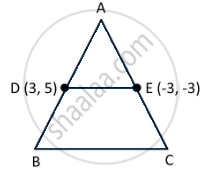Advertisements
Advertisements
प्रश्न
Statement A (Assertion): If the coordinates of the mid-points of the sides AB and AC of ∆ABC are D(3, 5) and E(–3, –3) respectively, then BC = 20 units.
Statement R (Reason): The line joining the mid-points of two sides of a triangle is parallel to the third side and equal to half of it.
विकल्प
Both assertion (A) and reason (R) are true and reason (R) is the correct explanation of assertion (A).
Both assertion (A) and reason (R) are true and reason (R) is not the correct explanation of assertion (A).
Assertion (A) is true but reason(R) is false.
Assertion (A) is false but reason(R) is true.
उत्तर
Both assertion (A) and reason (R) are true and reason (R) is the correct explanation of assertion (A).
Explanation:
Statement A (Assertion): If the coordinates of the mid-points of the sides AB and AC of ∆ABC are D(3, 5) and E(–3, –3) respectively, then BC = 20 units.

We need to use the theorem in Reasoning
The line joining the mid-points of two sides of a triangle is parallel to the third side and equal to half of it.
DE = `1/2` BC
2DE = BC
BC = 2DE
BC = `2 xx sqrt((-3 - 3)^2 + (-3 - 5)^2)`
BC = `2 xx sqrt((-6)^2 + (-8)^2)`
BC = `2 xx sqrt(6^2 + 8^2)`
BC = `2 xx sqrt(36 + 64)`
BC = `2 xx sqrt(100)`
BC = 2 × 10
BC = 20 cm
Thus, Assertion is true.
Statement R (Reason): The line joining the mid-points of two sides of a triangle is parallel to the third side and equal to half of it.
This is always true.
Here is a proof
In ΔABC,
D is the mid-point of AB
⇒ AD = DB
⇒ `(AD)/(DB)` = 1 ......(1)
E is the mid-point of AC
⇒ AE = EC
⇒ `(AE)/(EC)` = 1 ......(2)
From (1) and (2)
`(AD)/(DB) = (AE)/(EC)` .....(If a line divides any two sides of a triangles in the same ratio, 3 then the line is parallel to the third side)
∴ DE || BC
Hence proved
Thus, Reasoning is true.
APPEARS IN
संबंधित प्रश्न
If the points A(k + 1, 2k), B(3k, 2k + 3) and C(5k − 1, 5k) are collinear, then find the value of k
Let ABCD be a square of side 2a. Find the coordinates of the vertices of this square when A coincides with the origin and AB and AD are along OX and OY respectively.
Find the point on x-axis which is equidistant from the points (−2, 5) and (2,−3).
Find the value of x such that PQ = QR where the coordinates of P, Q and R are (6, -1), (1, 3) and (x, 8) respectively.
Name the quadrilateral formed, if any, by the following points, and given reasons for your answers:
A(-1,-2) B(1, 0), C (-1, 2), D(-3, 0)
In the seating arrangement of desks in a classroom three students Rohini, Sandhya and Bina are seated at A(3, 1), B(6, 4), and C(8, 6). Do you think they are seated in a line?
Show that the following points are the vertices of a rectangle
A (0,-4), B(6,2), C(3,5) and D(-3,-1)
Prove that the diagonals of a rectangle ABCD with vertices A(2,-1), B(5,-1) C(5,6) and D(2,6) are equal and bisect each other
Find the point on x-axis which is equidistant from points A(-1,0) and B(5,0)
ΔXYZ ∼ ΔPYR; In ΔXYZ, ∠Y = 60o, XY = 4.5 cm, YZ = 5.1 cm and XYPY =` 4/7` Construct ΔXYZ and ΔPYR.
If the point \[C \left( - 1, 2 \right)\] divides internally the line segment joining the points A (2, 5) and B( x, y ) in the ratio 3 : 4 , find the value of x2 + y2 .
What is the area of the triangle formed by the points O (0, 0), A (6, 0) and B (0, 4)?
A line segment is of length 10 units. If the coordinates of its one end are (2, −3) and the abscissa of the other end is 10, then its ordinate is
If (x , 2), (−3, −4) and (7, −5) are collinear, then x =
Find the point on the y-axis which is equidistant from the points (5, −2) and (−3, 2).
What are the coordinates of origin?
Find the coordinates of the point which lies on x and y axes both.
Find the coordinates of the point whose abscissa is 5 and which lies on x-axis.
In which quadrant, does the abscissa, and ordinate of a point have the same sign?
In which ratio the y-axis divides the line segment joining the points (5, – 6) and (–1, – 4)?
